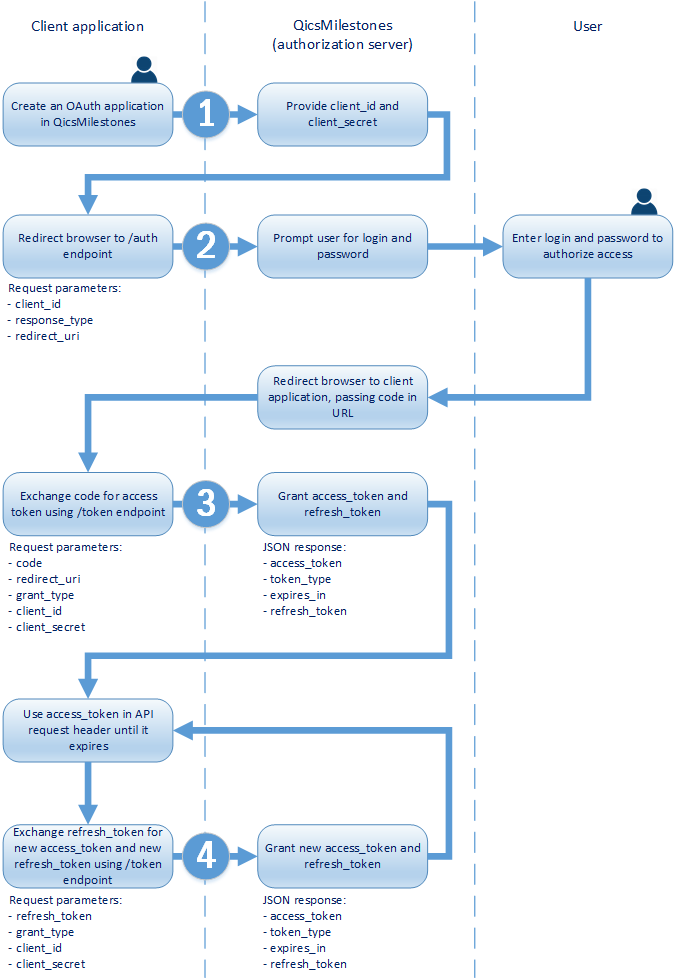When FortesMilestones API is used by a client, user account under which the API operations are performed, is identified by an access token instead of a user name and password.
Access token is issued to client aplication when user authorizes use of his account to the client application, in exchange of a one-time authorization code.
As soon as the client application receives an access token, it can perform any API operation under associated account as approved by owner of the account.
There are two API endpoints concerning OAuth2:
https://qicsmilestones.qics.nl/api/oauth2/oauth2/authhttps://qicsmilestones.qics.nl/api/oauth2/oauth2/token
The following picture shows overview of typical flow. Although OAuth2 (as per RFC6749) offers other authorization flows as well, FortesMilestones only supports authorization code flow.

Set-up of client ID and client secret is only performed once. Client secret and refresh token should be stored in a secure way by the client application since they represent actual credentials of the user who authorized it.
To get a Client ID and Client Secret, you need to create an OAuth application in FortesMilestones. You also must specify a Redirect Uri there. This Uri is used to pass authorization code to the client application. Make sure you configure the Redirect Uri as the endpoint your client application listens on.
When you have a Client ID, Client Secret and Redirect Uri, you can make an authorization request to obtain authorization code.
GET https://qicsmilestones.qics.nl/api/oauth2/oauth2/auth?response_type=code&client_id=<client_id>&redirect_uri=<redirect_uri>
Note: Redirect Uri configured for the OAuth application in Step 1, must be part of redirect_uri passed in the GET request above. Additional query string parameters are allowed and are preserved in redirect after successful authorization.
The access token is used to authorize API requests. Authorization code from Step 2 is exchanged for first access token and refresh token.
POST https://qicsmilestones.qics.nl/api/oauth2/oauth2/token
grant_type=authorization_code&code=<code>&client_id=<client_id>&client_secret=<client_secret>&redirect_uri=<redirect_uri>
{
access_token: "90f4068dfb914dd5aa9d46b1d08b3ef1",
token_type: "bearer",
expires_in: 3600,
refresh_token: "792c136bce02493fa6b28788ae3de7a2"
}
The returned access_token can now be used to access FortesMilestones API for next 3600 seconds. Add authorization header to API requests, such as:
Authorization: Bearer 90f4068dfb914dd5aa9d46b1d08b3ef1
POST https://qicsmilestones.qics.nl/api/oauth2/oauth2/token
grant_type=refresh_token&refresh_token=<refresh_token>&client_id=<client_id>&client_secret=<client_secret>
{
access_token: "d8a8a3aaf34b4af8b89ddb65000fc4e9",
token_type: "bearer",
expires_in: 3600,
refresh_token: "f9284bc0c8184f91be0769c4cce89b33"
}